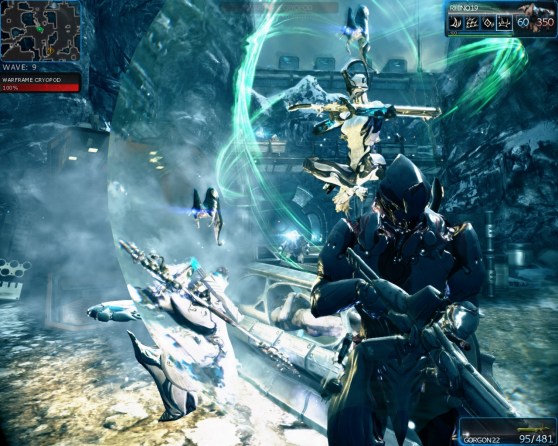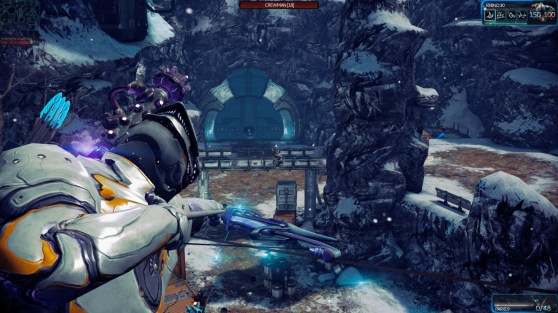Warframe has been a long time coming. The ambitious, free-to-play cooperative action game is the dream project of independent developer Digital Extremes, the studio behind titles such as The Darkness II, several entries in the Unreal Tournament franchise, and 2008’s highly underrated Dark Sector.
It’s the latter game that Warframe is so heavily based upon — or more appropriately, Dark Sector was based on a sliver of the concept that would eventually become Warframe, as creative director Steve Sinclair explains below. Warframe entered open beta on March 21 and has exceeded over 1 million players, rapidly climbing the ranks of popular game-tracking and social networking site Raptr.
Warframe uses premium Kickstarter-esque “founders packages” along with sales of Platinum, the in-game currency, to help fund its ongoing development. Awhile back, GamesBeat spoke with Sinclair about the game’s storied past, its monetization efforts, and the future plans for this potentially “endless” endeavor.
GamesBeat: Can you tell how Warframe came about? I understand it goes as far back as Dark Sector?
Steven Sinclair: It’s a long story. Most of it is boring and filled with naivety and hubris. We dreamed big and started building a next-gen engine before the Xbox 360 and PlayStation 3 were announced. Crazy ideas, like Arthur C. Clarke had said: “Any sufficiently advanced technology is indistinguishable from magic.” We started building and getting people excited about the visuals and the graphics, but when we hit the road to get it published, we hit a wall. WWII shooters were what all the marketing departments wanted. Many publishers came close but ran us through the “comparables” matrix and decided that a hard sci-fi game wouldn’t sell enough.
So we shelved the sci-fi. We adapted the pitch and toned it down so the company could survive. We lost a bit of control. We lost a bit of mojo. But we were stubborn and held on to some of the ideas in a subtle way. We took the race Tenno and named Dark Sector’s hero after him. We took the technology of Warframe and made it the virus that gave him his power. Then we crunched through the years of what it actually, properly took to build a game engine and a game from scratch, which we had completely underestimated. Then we shipped it just as it was getting a life of its own — before it was perfect. Despite its flaws, I appreciate you calling it underrated: I am still very proud of what we accomplished. I loved the Glaive. I loved how the powers evolve. But it was a death march to get it out, and my story for it sucked.
Years go by, and we make more and more awesome stuff. The Darkness II was incredible, a fantastic story with a great noir style. The Demon Arms are endless fun. We have Star Trek very near to ship, and it’s amazing to see Kirk and Spock both in terms of personality and as contrasting play-styles. The stealth/action choices the team built have brought a systemic depth to the game that will surprise people.
Now we are faced with new projects and what the future of the company is and where the industry is going. James built this company on shareware and saw the growing free-to-play market as getting back to our roots. The model is very much getting back to making a game that ships directly to customers that we have more ownership over and [more] interaction with our gamers. So we looked around at what ideas we had and decided that the sci-fi Dark Sector concepts would be a way to hit the ground running. It was time to make the game we always wanted to and to do it on our terms. Time to finish what we started back 10 years ago.
GamesBeat: Digital Extremes is no stranger to triple-A titles developed for big-name publishers. What are the specific advantages and disadvantages of doing a game like Warframe on your own versus Star Trek, The Darkness, etc.
Sinclair: Disadvantages: budget. Do-or-die stakes of self-funding. You have to do your own marketing, customer support, infrastructure — a whole new learning curve. Sacrifice established brands — or not a sequel — distribution channels and retail expertise.
Advantages: creative control — glorious creative control! More — much more — than a pittance of the profits. A chance to take risks and think differently. You can actually have an open and honest discourse with players instead of being on-message and repeating talking points — this is my favorite one.
GamesBeat: What’s your estimated goal for having the launch version of Warframe “complete” and out of beta?
Sinclair: A game like Warframe is really different for us. It’s about building a community of invested players and keeping them interested over a long period of time. This implies terms like “finished” or “complete” are a death sentence. Our dream for Warframe is that it is never complete but constantly growing and evolving. Shedding the bad stuff and adding new possibilities.
I’m hoping that Season One of Warframe kicks off this year, but we still have to face the fire of open beta.
GamesBeat: How do you go about designing the Warframes and their abilities?
Sinclair: It happens organically, which is code for chaotically. Scott McGregor, our design lead, sits next to me and writes Lua and experiments until it gets cool. We play it and iterate on it until we think it fits, and then we ship it. We don’t pretend to put [in] thousands of hours of thought or testing like our players do. They are fantastic at showing us the problems, and we try to repay them with fixing, buffing, and nerfing until it fits with the whole.
That said, there is a general design goal that is always the same: differentiation. Our ultimate goal is that if you asked the question, “Which is the best Warframe?”, everyone would have differing opinions. That is a sign we are making them diverse enough, deep enough to master.


